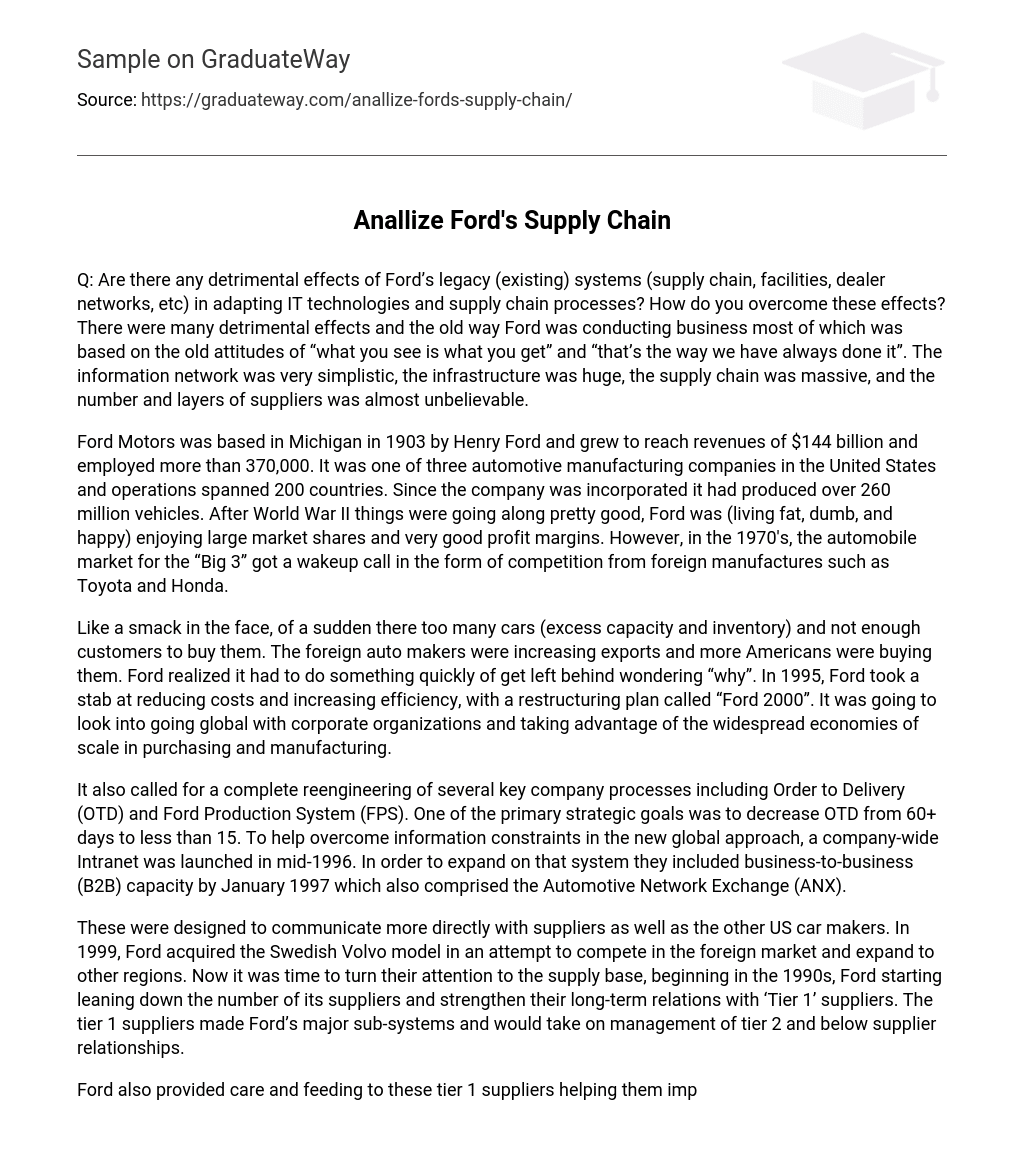Q: Are there any detrimental effects of Ford’s legacy (existing) systems (supply chain, facilities, dealer networks, etc) in adapting IT technologies and supply chain processes? How do you overcome these effects? There were many detrimental effects and the old way Ford was conducting business most of which was based on the old attitudes of “what you see is what you get” and “that’s the way we have always done it”. The information network was very simplistic, the infrastructure was huge, the supply chain was massive, and the number and layers of suppliers was almost unbelievable.
Ford Motors was based in Michigan in 1903 by Henry Ford and grew to reach revenues of $144 billion and employed more than 370,000. It was one of three automotive manufacturing companies in the United States and operations spanned 200 countries. Since the company was incorporated it had produced over 260 million vehicles. After World War II things were going along pretty good, Ford was (living fat, dumb, and happy) enjoying large market shares and very good profit margins. However, in the 1970’s, the automobile market for the “Big 3” got a wakeup call in the form of competition from foreign manufactures such as Toyota and Honda.
Like a smack in the face, of a sudden there too many cars (excess capacity and inventory) and not enough customers to buy them. The foreign auto makers were increasing exports and more Americans were buying them. Ford realized it had to do something quickly of get left behind wondering “why”. In 1995, Ford took a stab at reducing costs and increasing efficiency, with a restructuring plan called “Ford 2000”. It was going to look into going global with corporate organizations and taking advantage of the widespread economies of scale in purchasing and manufacturing.
It also called for a complete reengineering of several key company processes including Order to Delivery (OTD) and Ford Production System (FPS). One of the primary strategic goals was to decrease OTD from 60+ days to less than 15. To help overcome information constraints in the new global approach, a company-wide Intranet was launched in mid-1996. In order to expand on that system they included business-to-business (B2B) capacity by January 1997 which also comprised the Automotive Network Exchange (ANX).
These were designed to communicate more directly with suppliers as well as the other US car makers. In 1999, Ford acquired the Swedish Volvo model in an attempt to compete in the foreign market and expand to other regions. Now it was time to turn their attention to the supply base, beginning in the 1990s, Ford starting leaning down the number of its suppliers and strengthen their long-term relations with ‘Tier 1’ suppliers. The tier 1 suppliers made Ford’s major sub-systems and would take on management of tier 2 and below supplier relationships.
Ford also provided care and feeding to these tier 1 suppliers helping them improve their operation with techniques such as just in time (JIT), total quality management (TQM), and statistical process control (SPC). Next Ford needed to address its purchasing department which historically had been a standalone part of the company. They realized by looking at Dell’s business model that purchasing should be more aligned with product development, this would cut costs and increase efficiencies.
This would help standardize products and decrease costs without building large amounts of inventory. In addition, purchasing can search out suppliers to analyze which one can provide certain components at the most reasonable price based again on batch size. Then purchasing would work with product development to use that component in a new or existing design. The FPS resembled the Toyota Production System (TPS) and was an integrated system aimed at leaner, more efficient operations, and better responsiveness.
It adopted some of the TPS concepts but called them by different names such as Syncronized Material Flow (SMF) leveling production, and In-Line vehicle Sequencing (ILVS) which helped with just in time (JIT) delivery from suppliers. Ford also worked to enhance their retail distribution systems by launching the Ford Retail Network (FRN) in 1998, which would purchase dealers in a local market so that they were completing against the “real” competition and not themselves. Ford’s new vision was to create a model that allowed flexibility, predicable processes and delivered the product at the right time to the right consumer.





